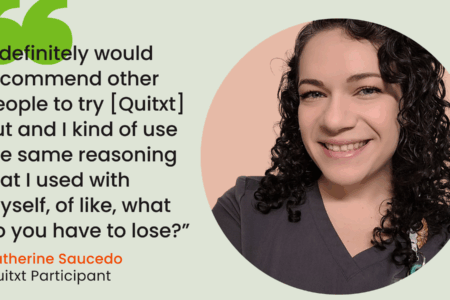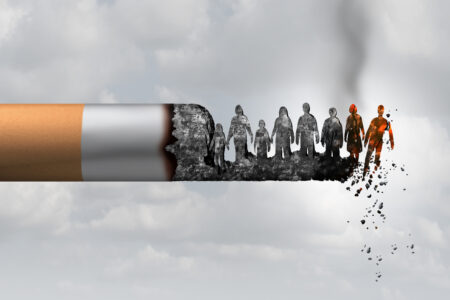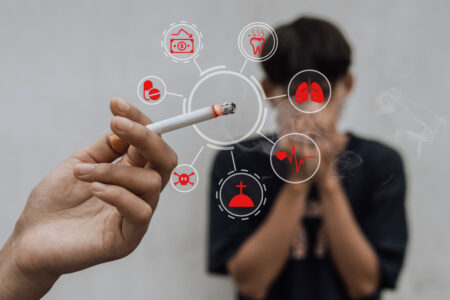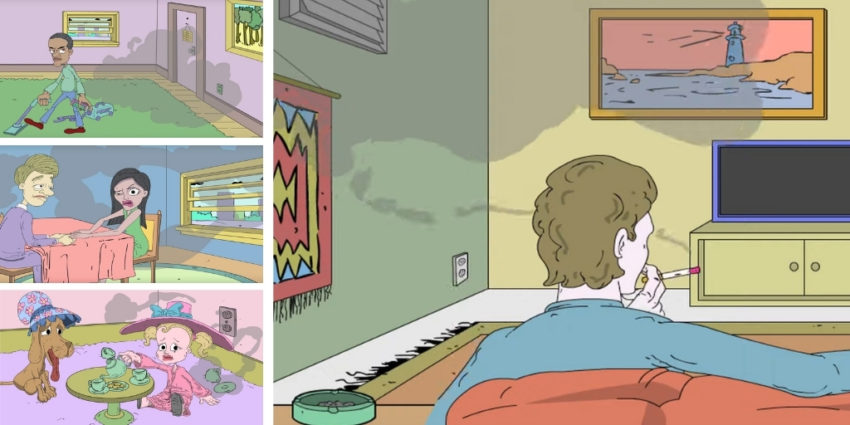
Share On Social!
Does someone smoke in your apartment complex?
You might be inhaling your neighbor’s secondhand smoke.
Inside multifamily dwellings, secondhand smoke can travel through doorways, halls, windows, ventilation systems, electrical outlets, and gaps around fixtures and pipes.
Secondhand smoke, already a cancer-causing killer of millions, also might contribute to the spread of coronavirus.
While there is no definitive link as of yet, there is enough scientific understanding of how particles travel to cause concern that smoke from cigarettes, cigars, and other tobacco products could be transferring COVID-19, said Dr. Loren Wold, a researcher at The Ohio State University.
“We know that the virus can attach to particles and can travel three, four, or five times farther than they would by simply being in the air,” Wold told Healthline.
This is why UT Health San Antonio’s new “Mil Gracias for Not Smoking Indoors!” campaign is promoting the benefits of being smoke-free indoors amid COVID-19.
What Is Secondhand Smoke?
When people use smokable tobacco, it emits many harmful substances into the air around them.
In fact, these harmful particles can stay in the atmosphere for hours and be spread around a 20 foot diameter, according to the National Institutes of Health.
“When someone smokes a cigarette, most of the smoke doesn’t go into their lungs. It goes into the air, where anyone nearby can breathe it,” WebMD states. “Even people who try to be careful about where they light up may not protect those around them.”
Secondhand smoke is a mix of mainstream smoke─the smoke exhaled by a smoker─and sidestream smoke from the burning tobacco product.
“[Sidestream] smoke has higher concentrations of cancer-causing agents (carcinogens) and is more toxic than mainstream smoke,” according to the American Cancer Society. “It also has smaller particles than mainstream smoke. These smaller particles make their way into the lungs and the body’s cells more easily.”
How Dangerous Is Secondhand Smoke?
Particles emitted from tobacco smoke enter people’s systems and wreak havoc—bad for smokers, but also bad for those experiencing secondhand exposure.
Secondhand smoke contains more than 7,000 chemicals.
“Hundreds [of these chemicals] are toxic, and about 70 can cause cancer,” according to the CDC. “Since the 1964 Surgeon General’s Report, 2.5 million adults who were nonsmokers died because they breathed secondhand smoke. There is no risk-free level of exposure to secondhand smoke.”
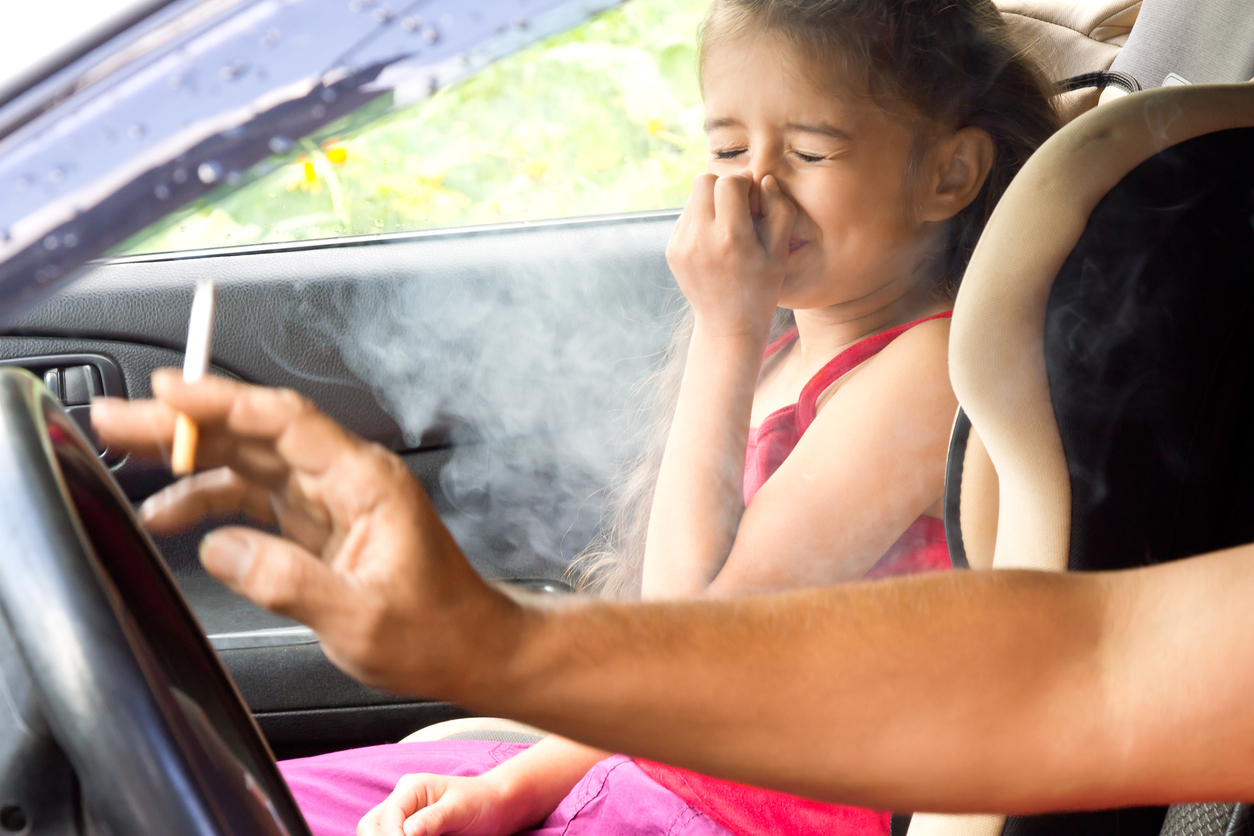 Researchers have linked secondhand smoke exposure with cancers of the:
Researchers have linked secondhand smoke exposure with cancers of the:
- Larynx (voice box)
- Pharynx (throat)
- Brain
- Bladder
- Rectum
- Stomach
- Breast
Health effects of secondhand smoke also include more severe asthma attacks, respiratory infections, ear infections, and sudden infant death syndrome (SIDS).
“Some of the health conditions caused by secondhand smoke in adults include coronary heart disease, stroke, and lung cancer,” according to the CDC. “Smoking during pregnancy results in more than 1,000 infant deaths annually.”
Why Is Secondhand Smoke a Health Risk for People in Multifamily Dwellings?
When COVID-19 struck, Dr. Claudia Miller immediately worried about the health of people quarantined at home with a smoker.
Miller, professor emeritus and leader of the Hoffman TILT (Toxicant-induced Loss of Tolerance) program at UT Health San Antonio, studies how smoke and other indoor air pollutants affect vulnerable people.
People with asthma or those with chemical intolerance report major, even disabling, symptoms due to secondhand smoke, Miller said.
She said she is especially concerned about people in multifamily dwellings, including apartments and condominiums, who share air with everyone in the building.
More than 1 in 3 nonsmokers who live in rental housing are exposed to secondhand smoke, as are 2 in 5 children—including 7 in 10 African-American children, according to the CDC. Also, nearly 24% of Mexican American-nonsmokers were exposed to secondhand smoke.
“Secondhand smoke moves freely in a building, just like water from a flood can travel via elevator shafts, stairwells, HVAC systems, wall outlets and other electrical and plumbing openings. People in apartment buildings have no choice about breathing secondhand smoke,” Miller said.
How Might Secondhand Smoke in Multifamily Dwellings Impact COVID-19?
First, consider how the coronavirus spreads.
The virus that causes COVID-19 spreads from person to person, primarily via aerosolized microscopic droplets produced when an infected person coughs, sneezes, talks, sings, laughs, or simply breathes.
“These particles can be inhaled into the nose, mouth, airways, and lungs and cause infection. This is thought to be the main way the virus spreads,” according to the CDC’s COVID-19 web page, last updated Dec. 2, 2020.
CDC also acknowledges the growing evidence for airborne, or aerosol, transmission of COVID-19.
One study in Environment International called airborne transmission high plausible. Another study in Clinical Infectious Diseases acknowledged that “there is more than enough supporting evidence [for airborne transmission] so that the precautionary principle should apply.”
Indeed, many scientists, epidemiologists, clinicians, and others “argue that the spread of COVID-19 by aerosols (that is, tiny droplets that can remain airborne long enough to travel significantly farther than the six-foot separation we’ve been told to observe) is both real and dangerous,” according to Scientific American.
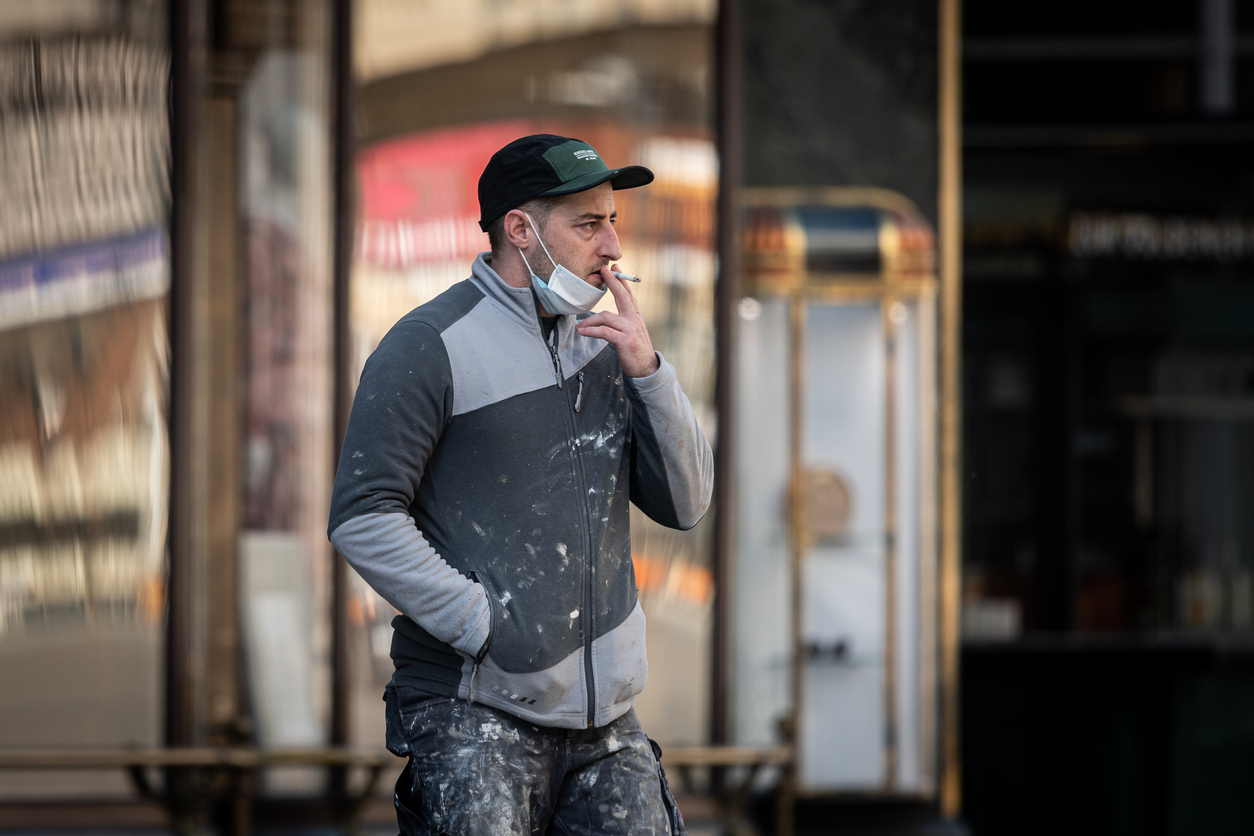 “A large proportion of the spread of coronavirus disease 2019 (COVID-19) appears to be occurring through airborne transmission of aerosols produced by asymptomatic individuals during breathing and speaking,” according to another study in the journal Science.
“A large proportion of the spread of coronavirus disease 2019 (COVID-19) appears to be occurring through airborne transmission of aerosols produced by asymptomatic individuals during breathing and speaking,” according to another study in the journal Science.
If airborne or aerosol transmission of COVID-19 is possible, it has implications for secondhand smoke exposure.
“If you smell somebody else’s exhaled cigarette smoke, then you are inhaling air that was in that person’s lungs,” William Ristenpart, a professor of chemical engineering at the University of California at Davis, told The Washington Post. “This means you could also be inhaling their virus-laden respiratory particles, which are composed of respiratory mucosa rather than ash.”
These airborne particles may travel farther and linger longer.
One study posited that coronaviruses can attach to secondhand smoke and aerosol particles and droplets, travel up to 27 feet, and transmit COVID-19 to older and younger non-smokers in the home.
Even though there is no definitive link, health experts remain worried that about the airborne transmission of COVID-19, especially in poorly ventilated confined spaces, like multifamily dwellings.
“Not only are [smokers] potentially spreading virus by not wearing a mask, they are blowing those droplets to the people around them to potentially get infected,” said Dr. Albert Rizzo, chief medical officer for the American Lung Association, according to the Associated Press.
We also know that current smokers have a higher risk for severe illness due to COVID-19, according to the CDC. Researchers have consistently connected worsened coronavirus outcomes to consistent smoking habits.
Another study found COVID-19 diagnosis among youth ages 13-24 was 7 times more likely among ever-users of cigarettes and e-cigarettes, and 6.8 times more likely among past 30-day users of cigarettes and e-cigarettes. A University of California, San Francisco report cites dozens of studies that “smoking makes COVID worse if you get it and smoking—and vaping—increase the risk of being infected and developing COVID-19.”
Taken together, this makes clean air imperative in multifamily dwellings.
“It is imperative to implement prohibitions against smoking in multi-unit housing,” according to the UC Merced Nicotene and Cannabis Policy Center. “In this regard, children, at risk, and even typically not at-risk groups should be protected against involuntary smoke exposure that increases the likelihood that [COVID-19] will spread to these populations.”
In San Antonio, Svatek wrote an op-ed for the San Antonio Express-News, citing the dangers of secondhand smoke for those in apartments and condos amid the city’s growing rates of COVID-19.
“Even during social isolation, individuals in multifamily housing units who are exposed to smoke can be at a greater risk of complications and dying from COVID-19,” she wrote. “Nearly 6,900 families are living in physically deficient conditions, and 15,269 housing units in San Antonio are overcrowded, and overcrowding can lead to a 3.7 times higher rate of confirmed cases per 1,000 residents, according to a recent study from California.”
What Does a Smoke-Free Policy in Multifamily Dwellings Look Like?
Private property owners have the legal right to adopt policies prohibiting smoking in all indoor areas of their buildings. This includes living units or on any part of their property, according to the American Lung Association.
“A city council or county board of supervisors can pass a [smoke-free multifamily dwelling] ordinance that becomes part of the municipal code that applies everywhere within city or county borders,” according to ChangeLab Solutions.
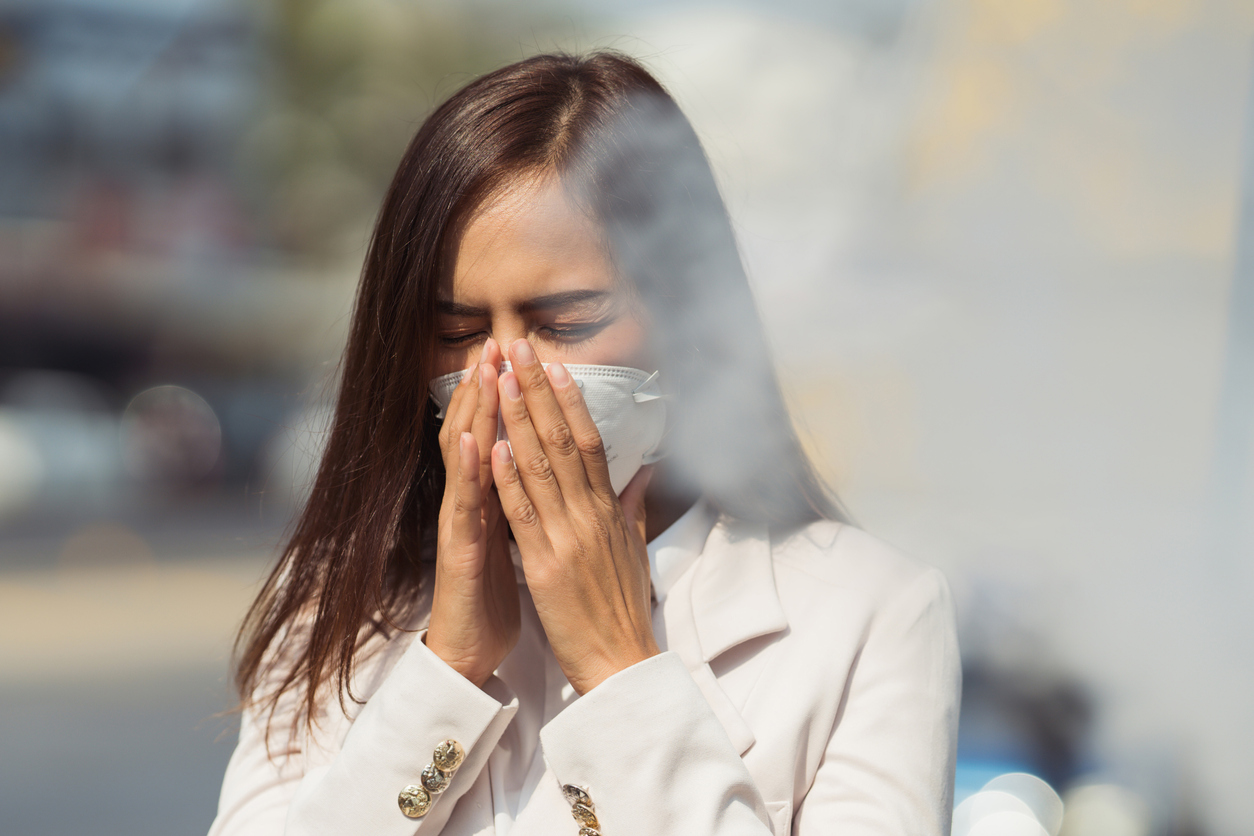 “Most smoke-free housing laws prohibit smoking in both common areas and individual units, and create smoke-free buffer zones around nonsmoking areas, doors, and windows,” the group wrote. “Smoke-free housing laws may include a variety of enforcement options, from imposing fines to empowering residents to pursue additional legal remedies.”
“Most smoke-free housing laws prohibit smoking in both common areas and individual units, and create smoke-free buffer zones around nonsmoking areas, doors, and windows,” the group wrote. “Smoke-free housing laws may include a variety of enforcement options, from imposing fines to empowering residents to pursue additional legal remedies.”
In California, dozens of cities have passed smoke-free multifamily dwelling laws. Berkeley, Calif., for example, prohibits smoking in all units and common areas of multi-unit housing.
ChangeLab Solutions crafted a customizable ordinance based on California’s success.
The Public Health Law Center and American Lung Association also created a model smoke-free ordinance in July 2020.
In San Antonio, the city’s public housing authority banned smoking in its units in 2012.
Moreover, on Dec. 5, 2016, the U.S. Department of Housing and Urban Development (HUD) finalized a rule that requires all public housing agencies across the nation to implement a smoke-free policy by July 30, 2018.
“The policy requires agencies to prohibit use of all lit tobacco products inside all dwelling units, indoor common areas, and agency administrative office buildings,” according to the HUD website. “The smoke-free policy must also extend to 25 feet from all housing and administrative buildings.”
Does a City Policy for Smoke-Free Multifamily Dwellings Infringe on Smokers’ Rights?
No, according to HUD.
Smoke-free policies are legal. Smoke-free policies also are not discriminatory because they do not prohibit anyone from renting a unit. They merely set rules for activities permitted on the property. There is no legal or constitutional right to smoke.
“The policies do not violate residents privacy rights and do not discriminate against residents who smoke,” according to the HUD website. “Smoke-free policies are about where people smoke, not about whether they smoke. People who smoke are not a protected class and do not have special legal status.”
One quarter of U.S. residents—approximately 79 million people—live in multifamily properties. This includes houses attached to 1 or more other houses and buildings with 2 to 50 or more apartments, according to HUD.
The majority are nonsmokers. But about half are exposed to secondhand smoke.
“Based on several studies, an estimated 44 percent to 53 percent of multi-unit housing residents that do not allow smoking in their home, have experienced secondhand smoke infiltration in their home from elsewhere in or around the building,” according to the American Lung Association.
The American Lung Association also shares a wide variety of videos, stories, and case studies of the beneficial impact of smoke-free housing policies (and quitting smoking).
“There might be a kid in the next door of [a smoker’s] apartment. That kid’s getting harmed by someone, their neighbor, smoking,” said Marcie Timmerman of Mental Health America in a video about Kentucky public housing. “When we came in with education about secondhand smoke, and even thirdhand smoke, and how that can make a whole building sick, we really changed that narrative. We turned it around. It wasn’t targeting a single person, it was investing in the health of everyone who lives in those facilities.”
How Would a Smoke-Free Policy Impact Private Apartment or Condominium Owners?
Smoke-free policies in multifamily dwellings are “fiscally responsible,” according to HUD.
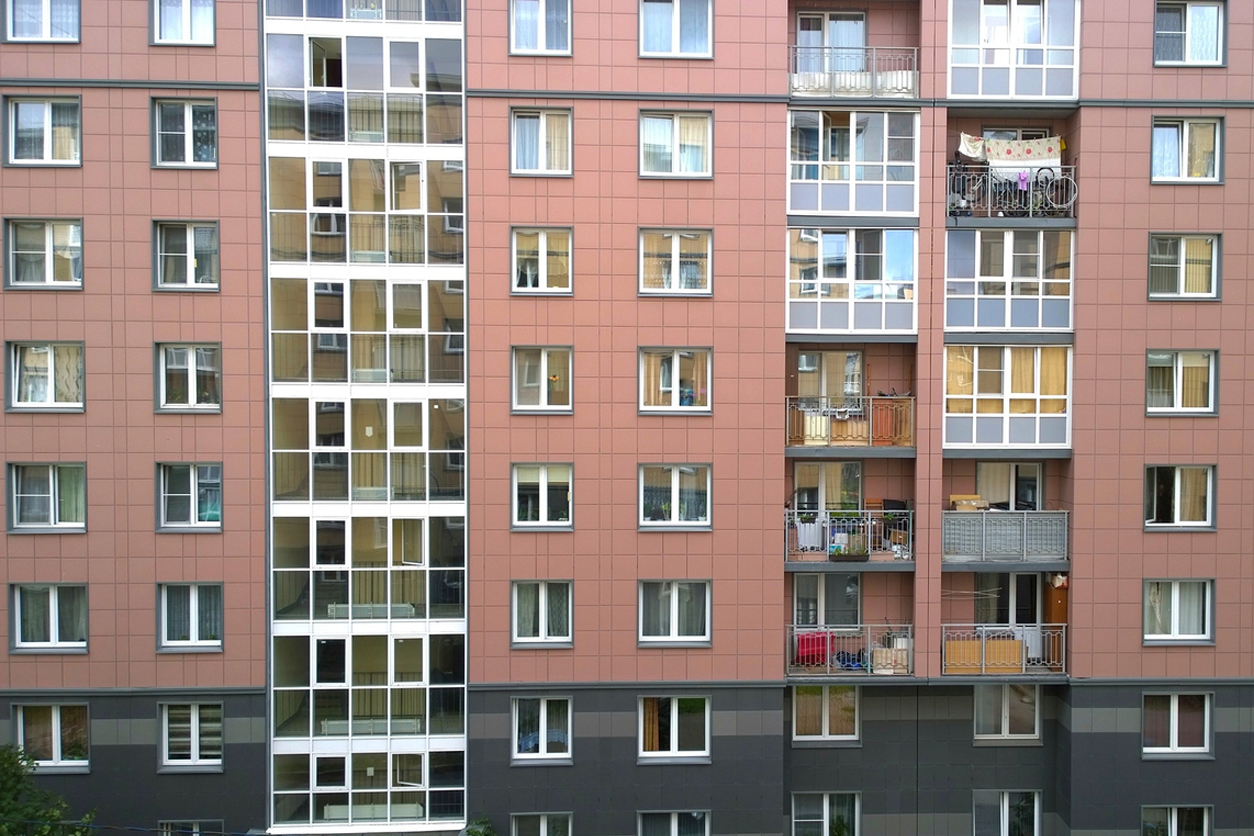 “Smoke-free policies reduce property maintenance costs, unit turnover time, and the risk of fires,” HUD reports. “Research has shown that ventilation and other air filtration technologies cannot eliminate the health risks caused by secondhand smoke exposure. Smoke-free policies are also good for the health of residents, staff, and guests.”
“Smoke-free policies reduce property maintenance costs, unit turnover time, and the risk of fires,” HUD reports. “Research has shown that ventilation and other air filtration technologies cannot eliminate the health risks caused by secondhand smoke exposure. Smoke-free policies are also good for the health of residents, staff, and guests.”
Here are just a few ways smoke-free policies benefit:
- Cost savings. Smoking in units can lead to serious property damage and increase the amount of time it takes to turn over a unit between residents. Also, the U.S. Fire Administration reports that smoking-related fires result in $326 million in property damage every year.
- Maintenance savings. Turning over a smoking unit can take more time and cost up to seven times more than turning over a smoke-free unit, resulting in a longer vacancy status and further increasing the wait for housing for qualified tenants.
- Insurance savings. Having a smoke-free policy is an opportunity to ask for reduced insurance costs. Although most insurance companies do not yet offer a specific credit for smoke-free policies, they are more likely to reward proactive clients with lower premiums.
- Reduced legal liability. Smoke-free policies can help avoid lawsuits because residents, staff members, and maintenance workers can file lawsuits over secondhand smoke. Claims may be based on legal precedents for nuisance, warranty of habitability, or the covenant of quiet enjoyment. Landlords, management companies, and smokers may all be found liable in such cases.
- Protect the health and safety of residents and staff. Secondhand smoke is a known human and animal carcinogen. This is a serious health threat to residents and staff, old and young, and pets and service animals. Smoking in the home is the leading cause of residential fire deaths and injuries. Almost 1,000 people die every year in smoking-related fires; half are tenants in multifamily dwellings, and a third of them are children.
Is There Another Way to Stop Secondhand Smoke in Multifamily Dwellings, Other than a Smoke-Free Policy?
No. This is because the movement of smoke between units cannot be controlled.
Ventilation and other air filtration technologies cannot eliminate all the health risks caused by secondhand smoke exposure, according to the American Society of Heating, Refrigerating, and Air Conditioning Engineers (ASHRAE).
“Secondhand smoke flows between units through air filtration systems and other means. It cannot be contained. Multifamily buildings share air ducts or vents, which means a lit cigarette in one unit can easily transmit tobacco smoke into another unit,” according to HUD. “Even in modern buildings designed to minimize air transfer among units, there is no way to guarantee that smoke will not be blown from unit to unit through open windows. A recent public housing study identified movement of smoke among units and evidence of improved air quality in buildings with smoke-free policies.”
Thus, smoke-free policies are the only way to prevent exposure to secondhand smoke in multifamily units, according to HUD, ChangeLab Solutions, and Svatek.
The ventilation industry leaders ASHRAE agree.
“At present, the only means of effectively eliminating health risk associated with indoor exposure is to ban smoking activity,” according to their 2010 position statement that they reaffirmed in 2019.
In 2020, the Public Health Law Center published a fact sheet on equitable enforcement of smoke-free policies in multifamily dwellings.
The Public Health Law Center in 2023 released a National Smoke-free Multiunit Housing Model Ordinance. This comprehensive model builds on the Center’s experience working on previous iterations of California and Minnesota models, years of experience in supporting communities and individuals with smoke-free housing policies, and an intensive three-year national stakeholder process.
“A graduated enforcement structure helps ensure better compliance with a smoke-free policy by providing multiple steps for enforcement and providing the opportunity for residents to change their behavior before infractions rise to the level of lease termination,” according to the agency.
What Else Can We Do to Promote Clean Indoor Air?
This answer is UT Health San Antonio’s new “Mil Gracias for Not Smoking Indoors!” campaign.
The Mil Gracias campaign is led by a group of local health experts: Dr. Amelie G. Ramirez, health disparities researcher and director of Salud America! at UT Health San Antonio; Dr. Claudia Miller, allergist/immunologist and professor emeritus at UT Health San Antonio; and Dr. Mandie Svatek, a pediatrician at UT Health San Antonio who leads the South Texas Asthma Coalition.
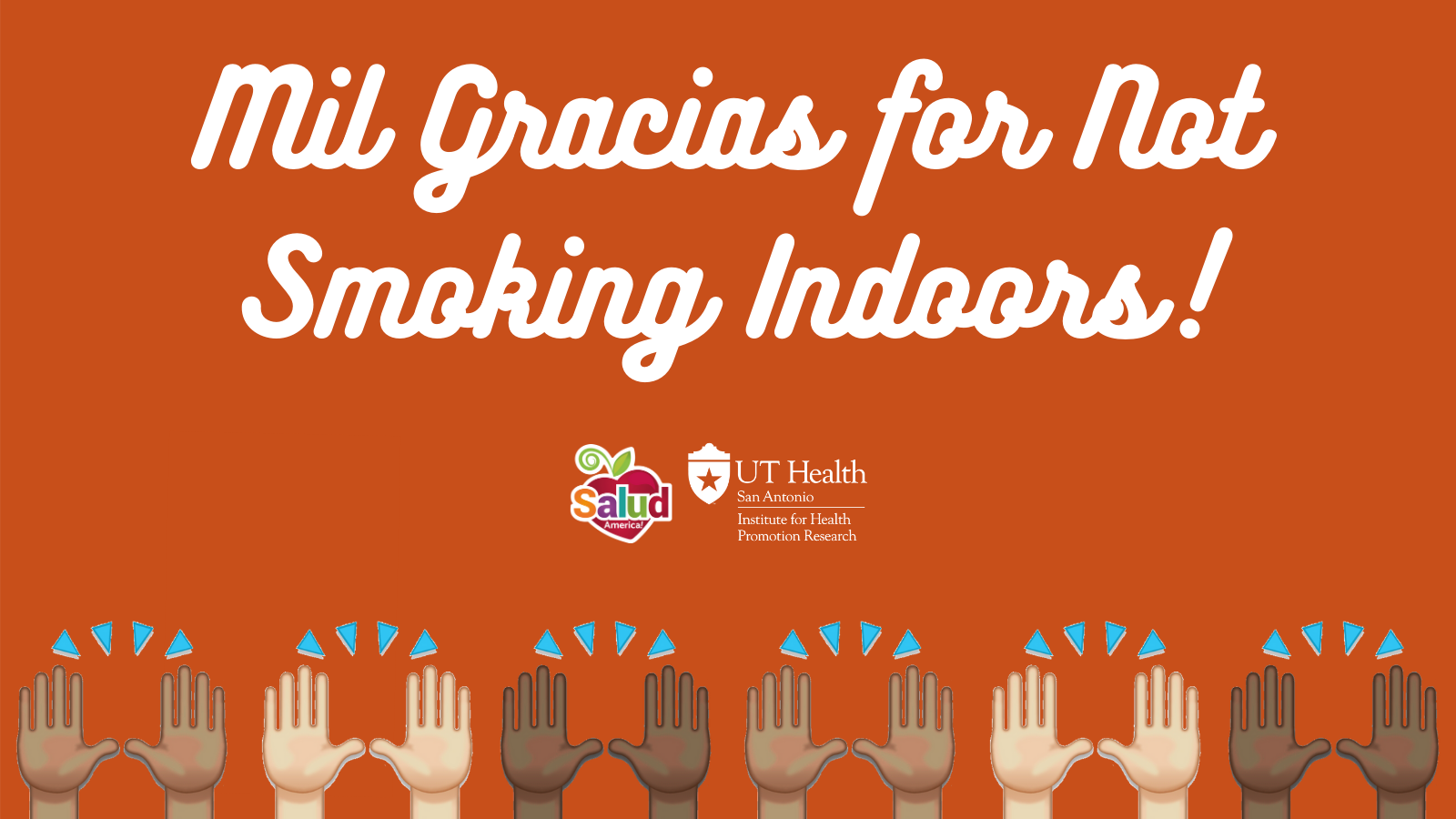 At the campaign website, you can take three big actions:
At the campaign website, you can take three big actions:
- Email a “thank you” message to a smoker for not smoking indoors to keep our families healthy.
- Sign a letter to acknowledge the harms of secondhand smoke exposure.
- Share the benefits of reducing secondhand smoke in multifamily dwellings.
“Smokers have the power to slow the spread of COVID-19 by taking it outside and away from people, protecting them from the known secondhand smoke dangers and the possibility of coronavirus airborne transmission,” Ramirez said. “Smokers who do not smoke indoors deserve our thanks.”
Mil Gracias aims to help people understand the dangers of secondhand smoke and take action to prevent any possible spread of the coronavirus and other tobacco-related health problems, Miller said.
“Most know that smoking harms the smoker, but few realize there is solid research linking secondhand smoke to asthma, SIDS, COPD, recurrent ear and pulmonary infections, many cancers, and, potentially, COVID-19,” Miller said. “The personal, social, and financial costs of secondhand smoke are incalculable.”
Quitting smoking isn’t easy, as nicotine is addictive.
But the impact is immediate.
“Quitting will help your lungs and heart to work better from the moment you stop. Within 20 minutes of quitting, elevated heart rate and blood pressure drop. After 12 hours, the carbon monoxide level in the bloodstream drops to normal,” according to the World Health Organization (WHO). “Within 2-12 weeks, circulation improves and lung function increases. After 1-9 months, coughing and shortness of breath decrease. Quitting will help to protect your loved ones, especially children, from exposure to second-hand smoke.”
You can get help from the free Quitxt Program from Ramirez’ team at UT Health San Antonio.
The Quitxt program, developed with the support of the Cancer Prevention and Research Institute of Texas, is a bilingual service for smartphones that sends messages via text or Facebook Messenger to help coach and encourage people on the journey toward smoking cessation.
Messages are culturally and regionally tailored to support young adults, including help using nicotene replacement options, such as gum, patches, and lozenges.
UT Health San Antonio and SA Metro Health also offer other quit-smoking services. Get individual tobacco cessation counseling led by UT Health Physicians by calling 210-450-9100.
Also, download the Salud America! Action Pack “Help Your City Adopt Smoke-Free Multifamily Housing!”
The action pack will help you engage local leaders in exploring a smoke-free multifamily housing policy for common areas and individual units.
“Experts say a smoke-free multifamily housing policy can protect the health of tenants and staff of apartments from secondhand smoke, as well as save property owners money in unit maintenance, fire prevention, insurance, and reduced legal liability,” said Dr. Amelie G. Ramirez, action pack creator and director of the Salud America! Latino health equity program at UT Health San Antonio.
Editor’s Note: Main animated images from American Lung Association’s Do You Smell Smoke video.
By The Numbers
24
percent
of Mexican American-nonsmokers are exposed to secondhand smoke

